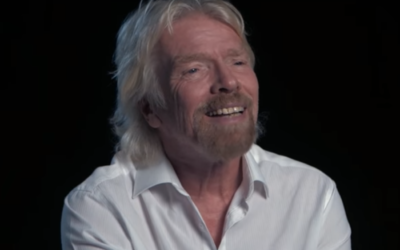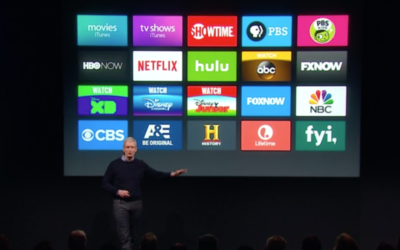The Goal Standard Challenge: Why You Must Be a ‘Mad Scientist’ to Achieve Your Goals
The Goal Standard Challenge: Why You Must Be a ‘Mad Scientist’ to Achieve Your Goals.
When it comes to goals, often people don’t know what ones they should try to achieve.
It’s normal.
In a Facebook Live, high-performance coach Todd Herman talks about having a better attitude – one focused on expectancy and exploration – when trying to achieve a goal.
Figure out what works and doesn’t work.
Once you have a goal in mind, take a lot of action and map those tasks into your days, he explains.
Related: 3 Guidelines for Creating a Support Group That Will Push You to the Next Level Check out his Facebook Live video to get more insight.
Also, download his accompanying worksheet, Mastering Your Weekly Success.
If you haven’t signed up for The Goal Standard Challenge, go to our content hub.
The hub has all the past weeks’ information, content, videos and resources.
Global Hackathons Turn Ideas Into Entrepreneurial Reality
With the advent of the digital age, anyone with a good idea and the ability to code can be considered to be a hacker — someone who can produce innovations that were not possible before the internet.
Forming those teams often occurs at an event called a hackathon.
“A hacker is anyone who can take limited resources or be in any type of constraint, time constraint, resource constraint, knowledge constraint, and create something from nothing or something from very little,” explained Sabeen Ali, who considers herself a hacker because of her childhood experience.
An American-born child of Pakistani immigrants, Ali lost her father at a young age.
“I lived in a house with a single parent (and) three kids.
Ali applied her ability to innovate to her company AngelHack, where it holds events, or hackathons, around the world.
AngelHack has organized hackathons in 92 cities globally where hackers form teams and compete for the best idea and product.
That means trying to get their word out there for their product,” said Adi Abili, who helps run the HACKcelerator program.
“Nobody in Sri Lanka has been exposed to something like this and we really grew as a team and as people these 12 weeks,” said Ravihans Wetakepotha of HypeHash.
“The open collaborative environment is the defining feature, I think, of Silicon Valley itself, and that culture kind of seeps in(to) the atmosphere and how everybody behaves — even when you’re here.
Mining resurgence to dominate early 2017 initial public offerings
Resources companies are set to dominate share market listings early in 2017, after having been on the nose last year.
Out of 23 companies that are currently planning an initial public offering (IPO) in 2017, almost half (11) are in the resources sector. “A significant proportion of these are focused on lithium and cobalt, a sign of the continuing push for materials used in the creation of energy cells,” observed Macus Ohm, a partner at accounting firm HLB Mann Judd, which compiled the IPO Watch report.
In a sharp reversal on last year, only one of the planned listings is a tech company.
Overall, last year was a solid year for IPOs, with 94 floats raising $7.5 billion.
The number of IPOs was up from 85 in 2015 and the value of the IPOs rose 7 per cent.
However, the lack of major listings meant that the amount of funds raised last year was less than half of the record $16.7 billion invested in IPOs in 2014.
HLB Mann Judd observed that the vast majority of companies achieved of exceeded their fund raising targets.
It also found that, on average, investors in IPOs beat the broader market, with a 16 per cent gain versus 7 per cent for the benchmark index.
However, subscribers to IPOs needed to be choosy, with a minority (40 out of 94) of floats finishing the year in the black, while the majority of IPOs lost value.
From Steven Spielberg to Richard Branson, Successful Entrepreneurs Share Their Secrets
From Steven Spielberg to Richard Branson, Successful Entrepreneurs Share Their Secrets.
Entrepreneur TV focuses on entrepreneurs, startups and stars who have created their own products or launched their own businesses.
You’ll learn success secrets from celebrities, productivity hacks from billionaires and more.
On the first episode of Entrepreneur TV, you’ll learn from successful stars like: Steven Spielberg Richard Branson Kevin Hart Tony Robbins Steven Spielberg shares the secret behind his million-dollar business.
Richard Branson tells you to “Screw it, just do it,” and other tips to succeed in life and business.
Business professional and motivational spearker Jeffrey Hayzlett shares his tips for a successful elevator pitch, and comedian Kevin Hart discusses his personal journey of entrepreneurship.
Tune in to hear real stories from Casper Cofounder and COO Neil Parikh, and John Rivers of Florida-based restaurant chain 4 Rivers Smokehouse.
You’ll learn the five things ridiculousely successful people do every day and workplace rules that you should be instilling in your office.
Click play to learn more.
Watch the new episodes Sundays on REELZ at 8am.
Giving Away Your Content and Marketing to Gain Customers
This video is part of a series brought to you by Entrepreneur’s book division, Entrepreneur Press, the publisher of Jill Schiefelbein’s book Dynamic Communication: 27 Strategies to Grow, Lead, and Manage Your Business.
Why should you give away free information as a business content marketing strategy?
What marketing strategies work to grow a business?
How do I use content marketing to increase sales?
Learn the answer to these questions and more in this video with entrepreneur, business owner and all-around-rockstar Jay Baer.
Want to see the full interview with Jay Baer?
Jay’s interview excerpt is featured in Dynamic Communication: Strategies to Grow, Lead, & Manage Your Business Chapter 1: What You Don’t Know Can Hurt You: Perceptions and Reality In this 27-video series, the author of Dynamic Communication: Strategies to Grow, Lead, & Manage Your Business, Jill Schiefelbein interviews stand-out companies and entrepreneurs to bring you great bites of information to help improve your communication and drive results.
Watch more videos from Jill on her YouTube channel and buy the book at Amazon.
We provide expertise and opportunities to accelerate brand growth and effectively monetize video and audio content distributed across all digital platforms for the business genre.
Click here to become a part of this growing video network.
4 rising startups in Japan
Two deals feature angel investors who were leaders of massively successful companies (Colopl and Mixi).
The one seed deal is by a new fund (also backed by Colopl) dedicated to supporting entrepreneurs under 30.
LaFabric LaFabric is a custom clothing service.
It just took home an undisclosed amount from a new VC fund – the Colopl Next New Generation Entrepreneur Fund.
The fund is for founders under 30 and is not limited to Japanese companies.
Hachidori’s founder, Takashi Van, started the company after living and studying in Australia, Japan, and the United States, and doing a stint in an investment bank.
Andpad Andpad is looking to make life easier for construction companies.
It has another advantage in the form of a new funding round.
Though details were not shared, the startup revealed that this round was made up exclusively of angels.
Contact him at david@techinasia.com if you want to get involved or are passing through Tokyo!
The Bouqs more than doubles funding with substantial Series C
The Bouqs more than doubles funding with substantial Series C. With Valentine’s Day just around the corner, The Bouqs Company has raised another $24 million for its online flower delivery service.
“Customers absolutely love The Bouqs Company, and it’s clear they are the next-generation leader in the space,” he added, citing the startup’s “tech-driven and proprietary supply chain, a stellar team and a $16B market opportunity in the U.S. alone.” I caught up with Tabis last week to get more details about how The Bouqs will spend its Series C, what the company has been up to since we last spoke a year ago, and why the startup is hiring so many executives from the fashion industry.
Venice is a really great spot.
So being near the water and sort of in that Venice vibe really works well for us.
So that will be another big focus, both hiring and growing that team, but then investing in the technology itself.
We really focus on the logistics optimization problem in flowers because these flowers are all over the world, and we need to get them very efficiently and in great quality with great freshness to our users, and so investing in smart systems and big data to really make sure that the best flowers are getting to right place at the right time as quickly as possible.
It’s growing really quickly — about 200 percent year over year.
So that’s been a really great success, and we’ll continue investing there.
We’ll continue to invest in the app.
You can go to the app, you see the flowers, you can buy the flowers.
Cheeky IPO? Nando’s is considering a float
Cheeky IPO?
Nando’s is considering a float.
Nando’s, the South African restaurant chain famous for its spicy peri-peri chicken, is reportedly considering a cheeky initial public offering (IPO).
Sources told Bloomberg Nando’s is in the process of speaking to advisers and planning a share sale.
Among its options, the Johannesburg-based company is mulling a London listing, the unnamed sources said.
In a statement, a spokesperson for Nando’s told Bloomberg reports about plans for an IPO are incorrect, and the company isn’t looking at ways to raise money.
Nando’s, which traded on the Johannesburg stock exchange until 2003 when it was delisted, would benefit from raising fund in a currency other than the South African rand.
After its creation in South Africa in 1987, Nando’s chicken restaurants have popped up all over the world with locations in the UK, the US, Australia, Canada, Malaysia and Singapore.
In September 2016, the company offloaded Gourmet Burger Kitchen to another South African restaurant chain after purchasing it from Clapham House for £30m in 2010.
Canadian government wants to be your startup’s first customer through Build in Canada program
Yet many Canadian startups avoid thinking about, much less pitching their innovation to, one of the biggest customers around: the federal government.
The benefit to companies in Canada is to get their first sale with the government.
“Saying you worked with the government is valuable because with that credibility, you can sell to big brands.” The program allows for the sale of innovative products and services — up to a $500,000 limit for each submitted new innovation.
Innovation that is commercial-ready,” Menges said.
“You may have a company that’s been around for 25 years, but you have a new product that’s innovative and you have the ability to commercialize your innovation.
When you’re applying, talk about the size of the market.
In truth, the biggest value for the system is the ability to test out a product and then tell other big companies that your company has sold to the federal government of Canada, said MetaOptima Technology CEO Maryam Sadeghi.
The real value of the system was going to big companies and telling them our product is being used by the federal government of Canada.
“Being able to say you worked with the government is hugely valuable — and worth millions — because with that credibility, you can sell to big brands,” Sadeghi said.
He has learned most of what he knows about tech startups and entrepreneurial spirit by interviewing some of the most innovative thought leaders here and abroad.
Employers Holdings, Inc. to Ring NYSE Closing Bell to Commemorate 10th Anniversary of Initial Public Offering
Employers Holdings, Inc. to Ring NYSE Closing Bell to Commemorate 10th Anniversary of Initial Public Offering.
RENO, Nev.–(BUSINESS WIRE)–Employers Holdings, Inc. (NYSE: EIG) will ring The Closing BellSM at the New York Stock Exchange (NYSE) today to commemorate the 10th anniversary of its initial public offering.
Douglas D. Dirks, Employers Holdings, Inc. President and Chief Executive Officer, and members of the board of directors and executive leadership team will ring the closing bell.
“I’m immensely proud of our growth and all we’ve accomplished together over the last decade.” Tweet this Employers Holdings, Inc. had its initial public offering in February 2007.
The company’s investment portfolio totaled $1.7 billion at the time of the IPO compared to $2.6 billion today.
A video of the event will also be archived on that same page after the livestream.
About Employers Holdings, Inc.
Employers Holdings, Inc. (NYSE:EIG) is a holding company with subsidiaries that are specialty providers of workers’ compensation insurance and services focused on select small businesses engaged in low-to-medium hazard industries.
Additional information can be found at: www.employers.com.
All rights reserved.
Snap Inc’s IPO will go public late next week, says report
20 Gmail Hacks Only Savvy Users Know
20 Gmail Hacks Only Savvy Users Know.
There’s an endless amount of tricks, tips and extensions that can boost your Gmail game.
From undoing a sent email to pre-writing messages to sending money — Gmail has taken email to the next level.
To keep up with all of these tips and tools available, here are 20 hacks to make you a Gmail power user.
Rent a luxury car for $1,500 a month? There’s an app for that
Starting in February, a beta test in New York City will allow a select few (sign up now!)
to rent a Cadillac for $1,500 per month.
The Book by Cadillac service will expand to other cities eventually.
You use an app to select the model you want, then a concierge delivers the car to your doorstep.
Someone will physically deliver that Cadillac to you now, but at some point in the future, the car will drive itself.
In the future, though, summoning a driverless car could become as common as jumping in a taxi.
The app isn’t available to test yet, but I imagine you can set up a schedule for when and where you want the car to be delivered.
If you can switch 18 times per year, could you do that in one month?
If there is high demand, you could be waiting a few hours for a swap.
It might be easier to take a taxi.
Apple TV lost more market share during the holiday season
According to the latest data from eMarketer: Apple TV “is at the bottom of the U.S. connected TV market, behind Google Chromecast and Roku, with its share shrinking.” Ouch.
That underwhelming assessment comes over a year after Apple relaunched Apple TV (in October 2015) with great expectations.
And even as Apple continues to add more apps, it still lacks a dedicated subscription service that Apple has reportedly been trying to pull together for several years now.
As a result, eMarketer reports that Apple is used by just 11.9 percent of connected TV consumers.
That’s down from 12.5 percent in September.
It also continues a steady drop from 12.6 percent in 2015 and 13.5 percent in 2014, according to eMarketer.
Apple had no doubt hoped to give Apple TV a bit of nudge late last year when it announced its “TV” app to make it easier to find and discover new shows.
But that didn’t seem to make much different for holiday shoppers.
By contrast, Google’s Chromecast climbed to 19.9 percent over the holiday quarter, up from 18.4 percent in September and 16.2 percent in 2015.
Of course, despite declining sales, it’s quite possible that Apple could be pulling in more revenue on the connected TV hardware.
Misys CEO Targets New IPO, Machine Learning and P2P Lending
Misys CEO Targets New IPO, Machine Learning and P2P Lending.
Before Misys tackles the public markets, it is targeting new products such as machine learning and peer-to-peer lending, he said.
A provider of banking software, London-based Misys was taken private in 2012 by Vista Equity Partners in a $1.3 billion deal.
“We decided to stop because the market wasn’t ready,” said Syed.
“It took some people by surprise about how much transformation we had been through.
Earlier in January, Misys revealed new software that will enable banks to offer peer-to-peer lending to customers.
Syed said it was still in early discussions with potential customers, but hoped to help banks recoup some of the ground lost to peer-to-peer startups such as Lending Club Corp. and Funding Circle Ltd. Misys is also branching out into machine learning.
Syed said such a product could catch errors such as when Deutsche Bank AG mistakenly transferred $6 billion to a hedge fund client, after a junior trader inputted the wrong figure.
Misys, which files its accounts in Luxembourg, posted $900 million in revenue for the 12 months through May 31, 2016, up 2 percent year on year, but down 4.7 percent from the year ended May 31, 2014.
“The destination is a public company,” said Syed.
Fitbit reportedly to lay off up to 10% of workforce
Fitbit reportedly to lay off up to 10% of workforce.
According to The Information, the wearable technology company will not only disclose results below expectations, but that it will also be laying off up to 10 percent of its workforce.
It’s unclear which department will experience the most cuts, but between 80 and 160 people are said to be impacted.
This action will also save Fitbit around $200 million in costs.
The reduction in workforce and earnings results are being blamed with a sluggish market, one that appears to be waning in its interest over fitness bands.
Fitbit likely recognized this trend recently and sought to move past its current wearable selection into more diverse holdings, evident through its Pebble acquisition last year and interest in Jawbone.
A source told The Information that Fitbit is interested in developing an app store, opening up its devices to third-party developers — Pebble plays a big part in that move, if true.
Should this be the route that Fitbit is taking, the layoffs could be viewed as an effort to restructure in order to not only save money, but shift the focus away from just a hardware company and into a dedicated software one.
James Park, Fitbit’s chief executive, once said that he views the device as being able to one day “save your life.” While some may view it as trendy to wear, Park believes it could be a medical aid.
Updated as of 6:14 p.m. Pacific on Sunday: Corrected to state that Fitbit will release information around Q4 earnings results.
HTC will give 1,000 Vive Trackers to VR developers — applications close February 7
HTC will give 1,000 Vive Trackers to VR developers — applications close February 7.
Vive today opened up applications for developers to get their hands on one of 1,000 Tracker units before they launch later in the year.
Successful studios will get one of an “initial batch” of Trackers, according to an official blog post.
To sign up you’ll need to fill out a form, listing details about both your company and the project you’re working on.
As the name suggests, the Vive Tracker is another peripheral that’s positionally tracked by the Vive’s base stations, just like the headset itself and its compatible controllers.
The difference here is that you can attach the kit to any sort of real world object to bring an accurate representation of it into the virtual world.
We’ve already seen the kit attached to the end of baseball bats and fire hoses, while other developers are pairing it with phones to enable local multiplayer in VR and even feet to enable full body tracking for virtual avatars.
Giving out units to developers is not a new concept for HTC.
Though undoubtedly costly, it’s an effective way to kick start the development of content for the platform.
The Vive Tracker is rolling out to the public in the second quarter, though a final release date or price has not yet been set.

















